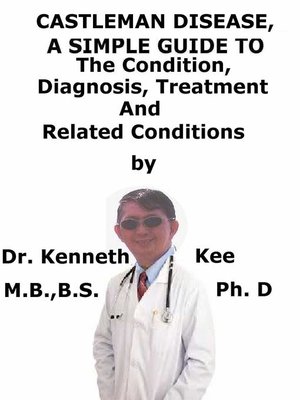Castleman Disease, a Simple Guide to the Condition, Diagnosis, Treatment and Related Conditions
ebook
By Kenneth Kee

Sign up to save your library
With an OverDrive account, you can save your favorite libraries for at-a-glance information about availability. Find out more about OverDrive accounts.
Find this title in Libby, the library reading app by OverDrive.



Search for a digital library with this title
Title found at these libraries:
| Library Name | Distance |
|---|---|
| Loading... |
This book describes Castleman Disease, Diagnosis and Treatment and Related Diseases
Castleman disease is an infrequent disorder that happens when too many cells proliferate in the lymph nodes, the small organs that filter out pathogens.
After a while, hard growths of lymph nodes form.
There is an overgrowth of cells in the body's lymphatic system.
Castleman disease can involve one or more lymph nodes in a single area of the body or it can involve multiple lymph node areas.
Types of Castleman Disease
Castleman disease happens in 1 of 2 ways.
1. Unicentric Castleman disease (UCD) involves one group of lymph nodes, often in the chest or abdomen.
It is the most frequent form.
This form involves a single or multiple lymph nodes in one area of the body.
It is also termed localized Castleman disease.
The precise cause of UCS is not clear.
Surgery to eliminate those lymph nodes normally cures it.
2. Multi-centric Castleman disease (MCD) is the other form.
It involves many lymph nodes.
Since it is so widespread, doctors cannot eliminate all of the involved nodes the way they can with UCD.
In this form, multiple lymph node areas in the body are affected.
About half of MCD cases are produced by HHV-8 infection in people with human immunodeficiency virus (HIV) or otherwise immunocompromised for other causes.
The remaining half of MCD cases are HHV-8 negative and are indicated as HHV-8 negative MCD or idiopathic MCD or iMCD.
iMCD can be further categorized intro 3 distinct medical groups:
a. iMCD linked with POEMS (Polyneuropathy, Organomegaly, Endocrinopathy, Monoclonal plasma cell disorder and Skin changes)
b. iMCD linked with TAFRO (Thrombocytopenia, Anasarca, Myelofibrosis, Renal dysfunction and Organomegaly)
c. iMCD, not otherwise specified (iMCD-NOS)
Medicines can manage these iMCD groups and keep it under control.
Microscopic subtypes of Castleman disease
There are also 4 subtypes, categorized by how the lymph tissue looks under a microscope.
1. Hyaline vascular type
This is the most frequent form.
It is normally in one region.
The patient probably does not have many symptoms.
2. Plasma cell type
This tends more likely to be multicentric and to produce symptoms.
3. Mixed type
This has regions of both hyaline vascular and plasma cell types.
4. Plasmablastic type
This is normally multicentric and produces symptoms.
An infection such as human herpes virus 8 (HHV-8) and possibly others and disorders with the body's immune system may induce Castleman disease.
Castleman disease may be linked with other cancers such as lymphoma.
Castleman disease involves the same numbers of males and females.
It can happen at any age group.
The precise cause is not clear.
It might affect disorders in the immune system, the body's main defense against germs.
It could also be linked to changes in the genes.
If the patient has HIV virus infection, the patient may have a higher risk of getting multicentric Castleman disease.
Since the immune system is weak, the patient is more prone to have disorders from another virus called HHV-8.
Castleman disease has similar symptoms to lymphomas, cancers that involve the lymph nodes.
The diagnosis is made by histological examination of an excised lymph node.
If the patient has the unicentric type, the patient may require surgery to eliminate the swollen lymph node.
If the patient has MCD, the patient will require treatment that works throughout the body, since the disease has extended...







